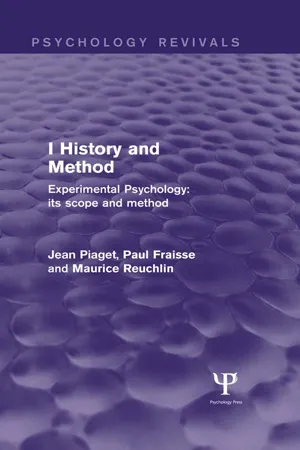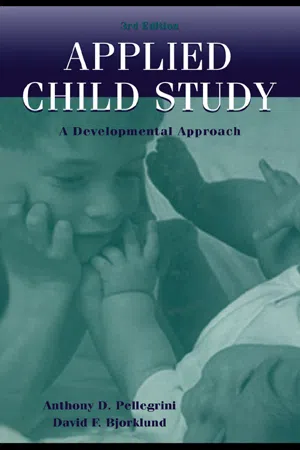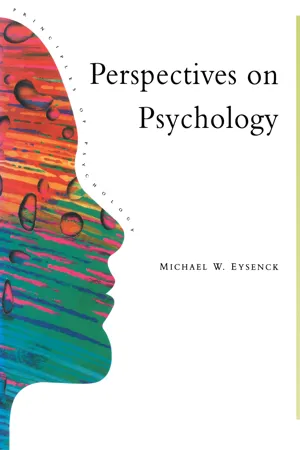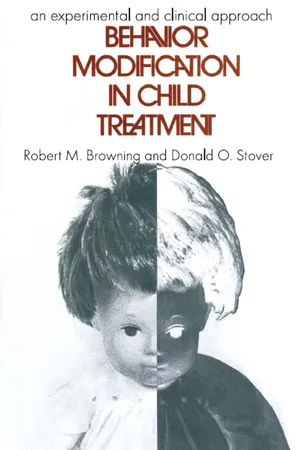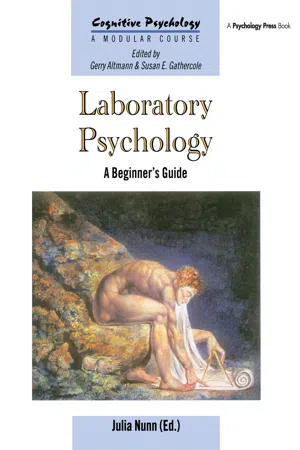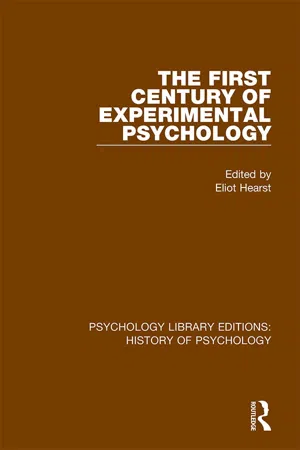Experimental Method
The experimental method in psychology involves conducting controlled experiments to investigate cause-and-effect relationships between variables. It typically includes manipulating an independent variable and measuring its effects on a dependent variable. This method allows researchers to establish causal relationships and make inferences about the impact of specific factors on behavior or mental processes.
8 Key excerpts on "Experimental Method"
- eBook - ePub
- Jean Piaget, Paul Fraisse, Maurice Reuchlin(Authors)
- 2014(Publication Date)
- Psychology Press(Publisher)
...Chapter 2 The Experimental Method Paul Fraisse 1 The nature of the Experimental Method Experimental psychology represents that body of knowledge acquired in psychology by the use of the Experimental Method. After a century of productiveness in the physical, natural and human sciences, this method no longer needs introduction. Moreover, it would be difficult to add anything to the work of Claude Bernard except that in each science the Experimental Method has its own procedures and rules, which are the outcome of difficulties encountered and overcome by past workers. We propose to try and explain the specific problems of the experimental approach in psychology. Whatever the actual subject matter of each experimental procedure may be the method remains the same in principle. Although the experimenter’s first move must be guided by the fact, he will not be satisfied with that. His aim is to discover new facts, 1 and he cannot do this unless he knows all the conditions governing their appearance. At that particular moment he is capable of foresight. But to achieve this end, the experimenter had had to connect together the intricate relationships between the essential facts, and the more complex his object the longer and more difficult the task will have been. It is a matter of disentangling a thread and of proceeding by stages in order to succeed. Each stage is characterized by the establishment of a relation between two or more facts. The graduated network of these relations constitutes the body of a science. The Experimental Method is really only a way of acquiring knowledge. Its essential feature is to maintain the coherence of a system of relations controlled by the experiment. This mode of knowledge is essentially distinct from that of philosophy, which is based on the evidence of propositions and the demands of reflexive thought, and culminates in a system of knowledge as coherent as possible...
- eBook - ePub
Applied Child Study
A Developmental Approach
- Anthony D. Pellegrini, David F. Bjorklund(Authors)
- 1998(Publication Date)
- Psychology Press(Publisher)
...We should draw what we can from each approach to help us better understand the complexities of childhood. SOME BASIC PREMISES OF Experimental MethodS Whereas naturalistic approaches attempt to study children in the everyday environment, the experimental approach attempts to create an experimental, often contrived, environment in which to examine children. Aspects of the environment thought to affect children’s behavior are manipulated and controlled. Through manipulation and control researchers can make causal inferences about these manipulations. Experimental environments can be real classrooms, as in the cases of field experiments of curriculum and design (P.K.Smith & Connolly, 1980), laboratories, where children are taken from their natural habitats and studied (Pellegrini & Perlmutter, 1989), or hybrid designs where parts of classrooms are experimentally controlled and manipulated (I.Jones & A.D.Pellegrini, 1996). These terms manipulate and control are crucial to the Experimental Method, and are discussed in greater depth later because they help us make causal inferences about sets of variables. Generally, experiments are conducted in order to isolate specific cause-effect relationships. That is, experimenters attempt to identify the effects of certain independent variables (e.g., crowding) on behavior, or dependent variables (e.g., children’s aggression). The independent variables are manipulated to examine their effect on the dependent measure. Other, extraneous, variables are controlled so that they do not influence the relation between independent and dependent variables, and thus cloud the causal picture. Experiments that give us insight into the effects of an independent variable on a dependent variable, without confounding effects of extraneous variables, are said to be internally valid. Experiments are thus most beneficial where the investigator is interested in identifying such cause-effect relationships...
- eBook - ePub
Quantitative Research Methods in Communication
The Power of Numbers for Social Justice
- Erica Scharrer, Srividya Ramasubramanian(Authors)
- 2021(Publication Date)
- Routledge(Publisher)
...Experiments can contribute to both basic research through theory building and to applied research through extending theories into practical solutions. As you will recall, a research hypothesis is a specific testable proposition of a relationship between variables put forth by the researcher. Experiments are excellent methods to test research hypotheses because they allow researchers to observe differences across groups to see if a proposed hypothesis holds or not. You will learn more about hypothesis testing using statistical methods in chapters 8 and 9. Whereas surveys provide an overall picture of any social issue of interest to the researcher, Experimental Methods are helpful in studying cause-effect relationships among variables. In fact, experiments are seen as a gold standard method for establishing cause and effect relationships between variables. Therefore, when the research design calls for examining whether one variable is affected by another, experiments are the best choice (Webster & Sell, 2014). The meaning of causation and the specific requirements for establishing causal relationships among variables will be discussed later in this chapter. Not only do experiments help identify causal effects, but they are also a powerful means for researchers to understand the theoretical mechanisms underlying a causal relationship. That is, they explain the process and the mechanism about why variables are related as the cause and effect. Thus, they help to test scientific theories and theoretical processes using empirical data-driven methods. For social justice research, in particular, the experiment is likely to be the go-to method for studying the effects of an intervention...
- eBook - ePub
- Michael W. Eysenck(Author)
- 2013(Publication Date)
- Psychology Press(Publisher)
...Experimental Method is used in more naturalistic surroundings, have the advantage of greater ecological validity than is generally found in the laboratory; but experimental control is often poor, so it can be difficult to replicate findings. Correlational designs are used by psychologists to examine possible associations or correlations between two variables; they do not enable cause and effect to be inferred, but can provide rapid accumulation of large amounts of data. Many important issues (e.g. smoking and physical health) cannot readily be studied with experimental designs, Although the great majority of studies using experimental and correlational designs involve groups of subjects, there is growing interest in the use of single-case studies. • Single-case studies can be very useful in suggesting guidelines for future research, and are particularly valuable when it is difficult to obtain homogeneous groups of subjects (e.g. in some clinical research). A great variety of data can be collected in psychological research; behavioural observations are the most commonly used form, but many psychologists collect psychophysiological or self-report data. Self-report data (e.g. questionnaires and interviews) are potentially valuable, but can be difficult to interpret because of social desirability bias and other problems. Archive material can also be useful, but can usually only be incorporated within a correlational design. Further reading A readable account of alternative research methods is provided by A.M. Colman in What is psychology? The inside story (London, Hutchinson, 1988). Some of the problems with the Experimental Method are discussed in a lively fashion by N. Heather in Radical perspectives in psychology (London, Methuen, 1976)....
- eBook - ePub
Behavior Modification in Child Treatment
An Experimental and Clinical Approach
- Robert M. Browning(Author)
- 2017(Publication Date)
- Routledge(Publisher)
...CHAPTER ONE The Experimental-Clinical Method The scientific method must be the basis for treatment of psychologically disturbed persons. The clinician should identify and measure behavioral problems in the same manner that the physical scientist approaches any natural phenomena. As an applied scientist, the clinician should combine basic psychological knowledge with current observations of his patient to form testable treatment hypotheses. Factual understanding of the patient’s behavior derived from experimental tests of these hypotheses should then be the basis for the design and execution of a total treatment program. Finally, the clinician should be capable of objectively evaluating his treatment procedures and, consequently, his understanding of the patient. This technological ideal is the experimental-clinical method. Experimental Methods are seldom employed in current clinical practice. Most clinicians have difficulty accepting science as even one of the boundaries of practice, and would vehemently reject the proposition that scientific methodology should stand as a central pillar of treatment. Instead, they state that the complexities of human feeling and action cannot be measured and that the treatment of unique individual behavior is the proper province of art. Traditionally, there has been a marked difference between the scientific and the clinical approaches to the problem of psychological disturbance. Arising from philosophical questions about the nature of man, and motivated by a search for knowledge, the scientific orientation has become formalized in the pure research of academic psychology. In contrast, the clinical approach has its roots in the humanistic tradition and is motivated by the desire to alleviate human suffering by treating disturbances of individual functioning. As clinical psychologists, the authors have been acutely aware of the continuing antithesis of scientific and clinical approaches to human behavior...
- eBook - ePub
- James P. Neelankavil(Author)
- 2015(Publication Date)
- Routledge(Publisher)
...8 Experimental Research Experimentation is a type of conclusive research in which the objective is to understand cause-and-effect relationships between variables. L EARNING O BJECTIVES After reading this chapter, students should be able to • Understand causal research • Know what the conditions for causality are • Understand validity in experimental designs • Know the various experimental designs • Understand the application of designs for various research objectives • Be familiar with the use of experimental designs in test marketing • Understand the general benefits of using experimental designs • Know the problems associated with experimental designs International executives need to understand why certain decisions they make have a greater impact on business results than some others. Will sales always rise when prices are lowered? Will factory workers always increase output when offered incentive bonuses? Causal research can help with these types of decisions. By scientifically isolating variables that have a greater impact on an outcome, managers can improve their decision-making skills. Experiments are widely used in product testing, tradeoff analysis, and test marketing. 1 Most causal research techniques are able to isolate those variables that have an effect on another variable. Furthermore, they help in determining the nature of the relationship between the cause variable and the effect variable, and they help predict the effect. Most causal research designs are structured and require careful planning. The major causal research technique used in business settings is experimentation. With the advent of computers and the ability to customize them easily, many researchers are using this technology...
- eBook - ePub
Laboratory Psychology
A Beginner's Guide
- Julia Nunn, Julia Nunn(Authors)
- 2018(Publication Date)
- Psychology Press(Publisher)
...4 Experimental versus correlational methods Peter Ayton T his chapter contrasts the two main research formats used to collect data in psychology, the experimental and the correlational study. As we shall see, each of these two research formats has advantages and disadvantages—particularly in terms of the kinds of inferences that can be made from the data collected. Aims The aim of this chapter is to instil in the reader an understanding of the correlational approach to the study of behaviour—its merits as well as its limitations. The correlational approach in psychology is crucial for certain types of investigation. There are however important—but often overlooked—limitations to the approach. After reading this chapter the reader should appreciate how they might benefit from the appropriate application of correlational research designs. The simple experiment: Active observation Experiments are designed in order to explore the causality of measurable phenomena. Conducting an experiment means making some action and measuring the effect of that action. As we have seen (Chapters 2 and 3) an experimenter will manipulate an independent variable and look for changes in a dependent variable. The experimenter attempts to hold all other variables constant because otherwise these might be responsible for any observed variation in the dependent variable. For example if we were interested in the effects of noise on students’ exam performance we might put some students into a noisy room and some into a quiet room and compare their exam results. However, if the noisy room was also much hotter than the quiet room then we would not know if it was the noise or the heat that was responsible for any difference. It is also possible that uncontrolled variables could conceal the real effects of an independent variable...
- eBook - ePub
- Elliot Hearst, Eliot Hearst(Authors)
- 2019(Publication Date)
- Routledge(Publisher)
...But judging by such tangible indices as divisional membership in the American Psychological Association, or comparable subgrouping in other countries, fewer than 10% of psychologists consider themselves to be experimental psychologists. Divisional membership is of course a recent phenomenon and thus must be considered a consequence rather than a cause of specialization. Perhaps for a start one might not go far wrong in characterizing experimental psychology as the profession of those who have founded, edited, written, and subscribed to the American Journal of Psychology, the Journal of Experimental Psychology, and such more recent parallels as the Quarterly Journal of Experimental Psychology, and who have structured the introductions to their research papers and their reference lists in terms of the handbooks of experimental psychology (Murchison, 1934; Stevens, 1951) and the successive editions of Woodworth (Woodworth, 1938; Woodworth & Schlosberg, 1954). More abstractly, the characteristic viewpoint of experimental psychologists goes much beyond the idea that in dealing with almost any empirical problem one should use so far as possible the controlled comparisons that define the Experimental Method. From before the founding of Wundt’s laboratory to the present day, experimental psychologists have proceeded on the much stronger assumption that many if not all of the phenomena of psychology can be investigated by bringing problems into the laboratory and studying them in relative isolation from the environmental and social contexts in which the behavior normally occurs. But one might well ask whether, in this restrictive sense, experimental psychology is possible...
